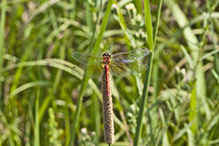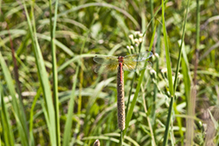band-winged meadowhawk
(Sympetrum semicinctum)
Conservation • Description • Habitat • Ecology • Distribution • Taxonomy
|
|
||||||||||||||
Description |
Band-winged meadowhawk is a small dragonfly. The face is yellow to brown. The thorax is brown and is covered with brown hairs. On juveniles the abdomen is dark brown with a black lateral stripe on each side. On mature males it is red. Females appear in two forms. On red form females the abdomen is red. On yellow form females it is whitish-yellow. All mature individuals have a black triangular marking on each side of each abdominal segment which, taken together, form a jagged, black line. The inner third of the forewing is amber. The inner half of the hindwing, from the point of attachment to the wing notch (nodus) is amber. All of the wing veins are black. In males and most females, the outer portion of the amber area on the hindwing is darkened, forming a band. The outer portion of both wings is clear except for the dark stigma on the leading edge of each wing. The legs are black. On the eastern form band-winged meadowhawk (S. s. semicinctum) each wing is amber from the base to the node. On the hindwings, it darkens in the outer region becoming a dark brown nodal band. The thorax is brown. On the western form band-winged meadowhawk (S. s. occidentale) all wings have diffuse amber coloring from the base to the node. The thorax is yellow to brown and there are narrow black lines on the side in the form of an irregular W. Eastern form band-winged meadowhawk lacks these markings. Both forms occur in Minnesota. |
Size |
Total length: ⅞″ to 1 3 ⁄16″ |
Similar Species |
Saffron-winged meadowhawk (Sympetrum costiferum) veins within the amber wing patch are reddish or orange, not black. |
Habitat |
Small ponds, shallow marshes. |
Ecology |
Season |
Late June to late September |
Behavior |
|
Life Cycle |
Eggs are laid among plants emerging from the water at the edges of ponds and in marshes while the female is still in tandem with the male. |
Naiad Food |
|
Adult Food |
|
Distribution |
||||||||||||||||||||||
|
||||||||||||||||||||||
Sources |
||||||||||||||||||||||
Occurrence |
||||||||||||||||||||||
Uncommon or locally common |
||||||||||||||||||||||
Taxonomy |
|
Order |
Odonata (Dragonflies and Damselflies) |
Suborder |
|
Superfamily |
Libelluloidea |
Family |
Libellulidae (skimmers) |
Genus |
|
Western meadowhawk was formerly considered as a separate species, Sympetrum occidentale. A recent molecular and morphological study (Dohlen, 2007) showed that the two species are identical at two genetic loci and that the morphological characters used to distinguish them overlapped. However, the geographic variation is both distinct and predictable. For that reason, the subspecies names have been preserved. |
|
Subordinate Taxa |
|
eastern band-winged meadowhawk (Sympetrum semicinctum semicinctum) western meadowhawk (Sympetrum semicinctum californicum) western meadowhawk (Sympetrum semicinctum fasciatum) western meadowhawk (Sympetrum semicinctum occidentale) |
|
Synonyms |
|
Libellula semicincta Libellula semicinctum Sympetrum californicum Sympetrum fasciatum Sympetrum occidentale |
|
Common Names |
|
band-winged meadowhawk |
|
Glossary
Nodus
On dragonflies and damselflies: the small notch on the lead edge of each wing about halfway between the body and the tip.
Stigma
In plants, the portion of the female part of the flower that is receptive to pollen. In Lepidoptera, an area of specialized scent scales on the forewing of some skippers, hairstreaks, and moths. In other insects, a thickened, dark, or opaque cell on the leading edge of the wing.
Visitor Photos |
||
Share your photo of this insect. |
||
This button not working for you? |
||
Ashley |
||
 |
|
|
Norm & Peg Dibble |
||
 |
||
Lynn Rubey |
||
 |
||
Adult male Band-winged Meadowhawk on a leaf in the prairie in The Big Stone National Wildlife Refuge. |
||
Kari Miller |
||
 |
||
MinnesotaSeasons.com Photos |
||
 |
 |
|
 |

Slideshows |
Band-winged Meadowhawk (Sympetrum semicinctum) |

|
Sympetrum semicinctum (Band-winged Meadowhawk) |

|
Band-winged Meadowhawk |

|

Visitor Videos |
||
Share your video of this insect. |
||
This button not working for you? |
||
|
Other Videos |
||
Band-winged Meadowhawk |
About
Uploaded on Sep 14, 2010 Band-winged Meadowhawk (Sympetrum semicinctum) at Lake Byllesby Dakota County Park near Cannon Falls, Minnesota, on September 14th, 2010. |
Band-winged Meadowhawk (Libellulidae: Sympetrum semicinctum) |
About
Uploaded on Jul 8, 2010 Photographed in the strong prairie wind at the Glacial Ridge NWR, Minnesota (07 July 2010). |
Band-winged Meadowhawk Sympetrum semicinctum |
About
Uploaded on Jul 21, 2009 Band-winged Meadow Hawk Sympetrum semicinctum, female, eating an insect and dash off to catch anotehr insect and gulp it up is short time. |
Band-winged Meadowhawk (Libellulidae: Sympetrum semicinctum) on Ground |
About
Uploaded on Aug 17, 2010 Photographed at the Turtle River State Park, North Dakota (16 August 2010). |
Dragonfly - Western Meadowhawk |
About
Uploaded on Sep 6, 2010 Western Meadowhawk dragonfly (presumably) filmed at Queen Elizabeth Park in vancouver, British Columbia - summer 2010. |

Visitor Sightings |
||
Report a sighting of this insect. |
||
This button not working for you? |
||
Ashley |
Location: Washington County |
| Lynn Rubey 8/3/2019 |
Location: Big Stone National Wildlife Refuge Adult male Band-winged Meadowhawk on a leaf in the prairie in The Big Stone National Wildlife Refuge. |
 |
MinnesotaSeasons.com Sightings |
||

Created: Last Updated: © MinnesotaSeasons.com. All rights reserved. |




